Return to my Checkers pages
Go to my home page
Easy Checkers Problems
Copyright 2002 etc., Jim Loy
You may print this and show it to
others. But, this article will eventually be part of a book that I am writing.
So, please do not distribute it widely.
If you need help reading checkers notation, please print out the
numbered board.
Also see Loy's Checker Problems and
Jim's Endings. These are some "easy" checkers problems
which have come up in my work on various openings, and mail games. The
solutions to most of them should come to you with little difficulty. If they
don't, then that is a serious flaw in your game. A Master would see the
solution to most of these in just a few seconds. Some of these contain surprise
moves, but none is complicated. The solutions are at the end of this
article.
|
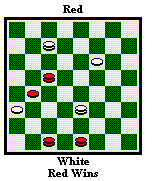
Problem #1:
This one should be fairly easy. |
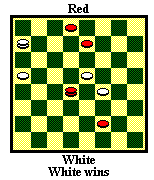
Problem #2:
This position is similar to one that could have come up in one of
my mail games. |

Problem #3:
This one should be fairly easy. |
|

Problem #4:
This came up in during the editing of the 2000 I-D booklet.
|

Problem #5:
This should be simple. |

Problem #6:
This simple draw was called a RW, by Churchill. |
|

Problem #7:
This position is from Nigel Proffitt - Jim
Loy, 1985-86 Friendly USA vs. Great Britain Match. |
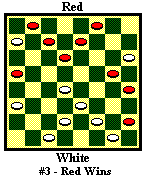
Problem #8:
I played this on the USA Today Sports Center Network (which no
longer exists). |

Problem #9:
This was the end of Swanson-Loy, 1991 I-D Mail Tournament.
|
|
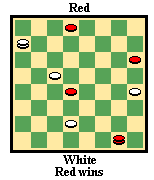
Problem #10:
This position could have come up in one of my games in the 2001
National Go-As-You-Please Tournament in Vegas. |
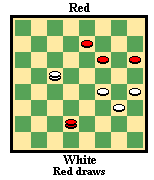
Problem #11:
Remember this one; it is a common ending idea. |
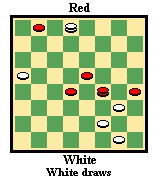
Problem #12:
I was studying an opening. |
|
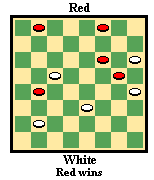
Problem #13:
This is from an email game of mine. |

Problem #14:
This is from my study of an opening. |

Problem #15:
This might have come up from the previous problem. |
|
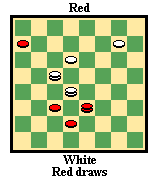
Problem #16:
This is from my study of an ending by Matt Long. |
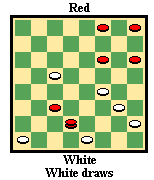
Problem #17:
This is from Churchill's Compilations, where it is called a
RW. |

Problem #18:
This is from the Childers-Fortman 1994 WCM booklet. |
|

Problem #19:
This is shown as a draw in Churchill's
Compilations. |
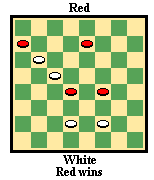
Problem #20:
This is shown as a draw in Churchill's
Compilations. |
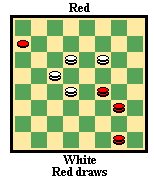
Problem #21:
I composed this and the next one back in the 1980's when I was
learning to play checkers. I thought they were both difficult. |
|
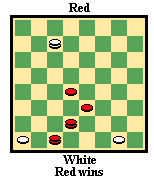
Problem #22:
Red wins two different ways (which is a flaw in the
problem). |

Problem #23:
This was called a draw in Churchill's
Compilations. |
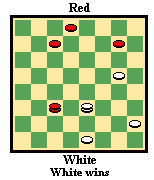
Problem #24:
This is similar to a position in one of my mail games (with a
piece added), and should be simple. |
|

Problem #25:
This could have come up in one of my email games. |

Problem #26:
This is based upon a more complicated position. |
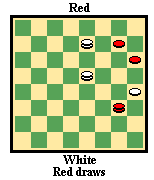
Problem #27:
This too is based upon a more complicated position. |
|
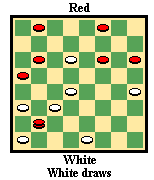
Problem #28:
A position in Churchill's Compilations. |

Problem #29:
A position in the Mount Sterling Advocate. |
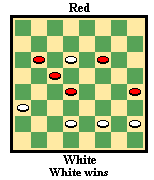
Problem #30:
D. Brattin - R. Munzinger, 1973 Lakeside, final position, agreed
draw. |
|

Problem #31:
I was studying an opening. |
|
|
Solutions:
Solution #1: 30-26! 23-30 14-18 RW.
Solution #2: 13-9 18-11 19-15 11-18 9-6 WW.
Solution #3: 28-24* 19-28 26-31 20-24 30-25 (or 30-26) WW.
Solution #4: 14-17 (easy) 3-10 (23-14 is the same) 25-30 draw.
The move before the diagram was 8-3. White had to do that (or 26-22 7-11 draw)
because Red was threatening 25-30 and 14-17 anyway.
Solution #5: Simple: 31-27 2-9 18-23 9-18 23-14 draw.
Solution #6: 17-14 (Mr. Churchill should have seen that at a
glance) 9-18 19-15 draw.
Solution #7: White draws immediately with 22-17! draw. Continue
13-22 26-17 31-26 15-11 (careful) 25-30 18-15 draw.
Solution #8: 3-8 12-3 13-17 21-14 10-17 3-10 6-31 RW. This
position is in my page on the In and Out Shot.
Solution #9: 21-17 13-31 32-28 31-24 28-3 WW. This position is in
my page on the In and Out Shot.
Solution #10: 32-27 14-10 (26-23 27-24 RW) 27-31 10-6 31-22 RW.
White lacks a waiting move.
Solution #11: 7-10* 14-16 26-23 draw.
Solution #12: 27-23! draw.
Solution #13: 17-21 wins the piece, as 25-22 16-19 RW. This was
the end of Loy-Bronty, tournament PO#43 in the USA Today games service.
Solution #14: 12-16! 19-12 11-15 draw, regains the piece, and
both players king two pieces.
Solution #15: 9-14 15-6 (15-24 draws) 14-18 draw.
Solution #16: 5-9 draw. This kind of move should come to your
mind instantly, as a possibility.
Solution #17: 19-15 11-18 29-25 easy draw.
Comments: Our position comes from this line: 11-15 23-19 9-14 22-17 6-9
(Souter) 17-13 2-6 26-22 (25-22 is more popular) 8-11 22-17 14-18 17-14? (25-22
is PP to draw) 10-17 21-14 18-22 19-10 6-15 13-6 1-17 25-18 15-22 30-25 7-10
25-18 17-22 24-19 10-14 18-9 5-14 27-24 14-17 32-27 17-21 27-23 21-25 23-18
25-30 18-14 30-26? (30-25 WW, Loy) [diagram] 19-15 (Churchill gave 25-22
which is illegal, to a WW) as above.
Solution #18: 22-18 (Childers gave 32-27 to draw) 14-23 16-11
8-15 (or 7-16 similar) 28-24 WW.
Comments: This is the opening: 9-13 23-18 11-16 18-14 10-17 21-14 6-9
26-23 (or 22-18 previous problem) 9-18 22-15 (or 23-14) 16-19 23-16 12-19 25-22
1-6 29-25 (or 22-18) 7-10 31-26 5-9 (10-14 draws PP) 24-20 (or others) 9-14
27-23 (22-18? seems to lose) 2-7? (8-12 seems to draw) 23-14 10-19
[diagram].
Solution #19: 23-27 32-23 6-9 RW.
Comments: Roberts-Park, in Churchill's Compilations: 10-14 23-19
11-16 19-15 16-19 22-17 7-10 17-13 3-7 25-22 14-17 21-14 9-25 29-22 7-11 30-25
11-18 22-15 5-9 27-23 2-7 23-16 12-19 31-27 7-11 26-22? (27-23 or 24-20 draw,
Loy) 11-18 22-15 10-14 24-20 19-23 27-18 14-23 20-16 8-12 16-11 9-14 11-7
[diagram]. Here Red moved 6-9?? to draw.
Solution #20: 18-23 27-18 7-10 RW.
The opening: 10-14 24-20 6-10 27-24 11-15 24-19 15-24 28-19 8-11 22-18
3-8 25-22 11-16 20-11 8-24 32-28 4-8 28-19 8-11 22-17 9-13 18-9 13-22 26-17
5-14 30-26 14-18 23-14 11-15 19-16 12-19 31-27 (17-13 10-17 21-14 19-24 29-25
is also called a draw in Churchill's Compilations, but is a RW) 15-18 17-13
10-17 21-14 1-5 29-25 2-6 25-21 6-10 13-9 10-17 21-14 [diagram].
Solution #21: 5-9 14-5 19-16 draw.
Solution #22: 30-25 (or 23-27 first) 29-15 23-27 RW.
Solution #23: 14-10! WW (simple, but is a surprise).
The opening: 10-15 21-17 15-18 22-15 11-18 23-14 9-18 26-22 7-11 22-15
11-18 17-14 8-11 24-19 4-8 25-22 18-25 29-22 11-16? (6-9 draws)
[diagram].
Solution #24: 16-11 (or 31-26 first) 8-15 31-26 22-31 23-27 31-24
28-1 WW.
Solution #25: 26-22 18-25 11-15 draw.
Solution #26: 18-22 draw. Question: If the pieces on 28
and 20 are not there, is this position a WW?
Answer: Even though it takes 20 or so moves, it should be easy to
see that the piece on 11 is lost: 18-22 15-24 22-31 24-19 31-27 30-25 wins the
piece.
Solution #27: 24-19 15-24 8-11 draw.
Solution #28: This shot should be easy: 22-17 13-22 18-14 9-18
31-26 draw.
From 9-13 22-18 11-15 18-11 8-15 24-20 7-11 25-22 5-9 23-18 4-8 27-23
10-14 28-24 12-16 32-28 8-12 24-19 15-24 28-19 6-10 30-25 10-15 19-10 16-19
23-7 14-30 22-18 2-11 25-22 30-25 [diagram] 31-26? loses in Churchill's
Compilations.
Solution #29: This is too easy: 19-15 10-19 27-23 or 27-24. This
is a problem by W. Duff, in the Mount Sterling Advocate, Feb. 20, 1940.
As it turns out, the diagram was a typo; the piece on 31 should be on 30. Mr.
Duff gave 30-26 to win an interesting and difficult ending (slightly marred by
a couple of bad moves and a couple of inappropriate asterisks), which begins
like this: 30-26 10-14 (11-15 27-24 20-27 26-23 WW) 28-24 14-17 26-23 18-22
23-18 22-26 19-16 WW.
Solution #30: 10-6 11-15 (or 11-16) 28-24 (apparently 6-1? was
expected) WW.
Solution #31: 24-19 16-23 6-9 RW.
Return to my Checkers pages
Go to my home page






























